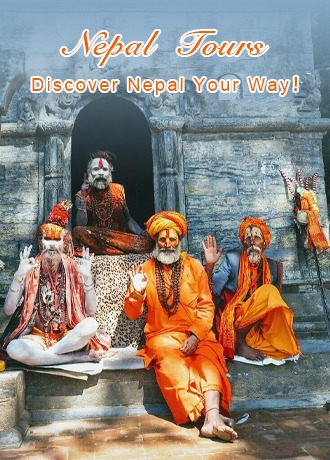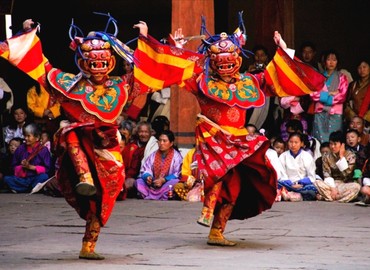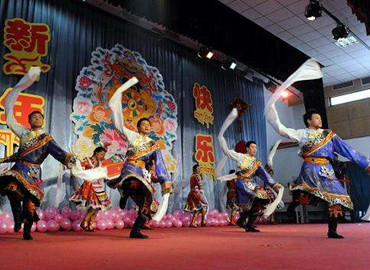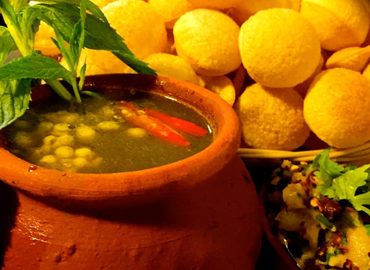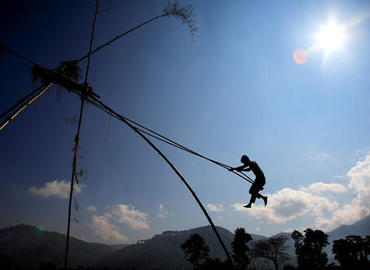Grand Festivals and Holidays of Nepal
- Last Updated : 11/04/2025
Nepal is known as the "state of festivals". Almost every few days, there is a festival, sometimes even a festival followed by a festival, which is rare in the world. There are more than 300 national festivals in Nepal. Few countries in the world like Nepal stop daily work for festivals. Nepalese spend almost one-third of their time preparing for festivals every year. Most Nepalese festivals originate from the worship of various gods. The government stipulates that there are more than 50 holidays.
There are almost all kinds of festivals throughout the year. So if you travel to Nepal, especially to the Kathmandu Valley, you will definitely encounter a certain festival. For tourists, you can experience the local religious culture and traditional customs by participating in different Nepalese holidays and festivals. Here’s a list of the 15 grand festivals of Nepal…
Maha Shivaratri
Date:
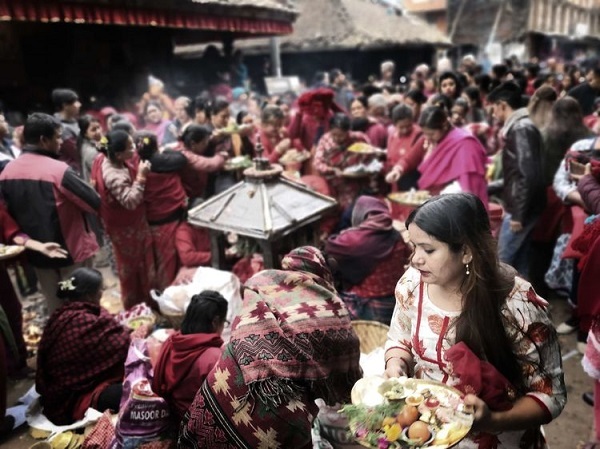 Maha Shivaratri, the Night of Great Lord Shiva, is one of the most popular Hindu festivals in Nepal. According to the Hindu calendar, Maha Shivaratri is celebrated on the 13th night or 14th day of Phalguna (the twelfth month in the Hindu calendar) each year. This Nepali festival is held on the date of the wonderful marriage of Lord Shiva and Parvati. Therefore, Hindus believe that sincere worship of Maha Shivaratri will lead to a long marriage and many children. Nepalese women often choose this day to get married so that their husbands will live a long and healthy life under the blessing of the gods.
Maha Shivaratri, the Night of Great Lord Shiva, is one of the most popular Hindu festivals in Nepal. According to the Hindu calendar, Maha Shivaratri is celebrated on the 13th night or 14th day of Phalguna (the twelfth month in the Hindu calendar) each year. This Nepali festival is held on the date of the wonderful marriage of Lord Shiva and Parvati. Therefore, Hindus believe that sincere worship of Maha Shivaratri will lead to a long marriage and many children. Nepalese women often choose this day to get married so that their husbands will live a long and healthy life under the blessing of the gods.
The best place to go for this festival is Pashupatinath Temple, a temple of Lord Shiva in the east of Kathmandu, which is also known as the "Temple of Burning Corpse".
Lhosar
Date:
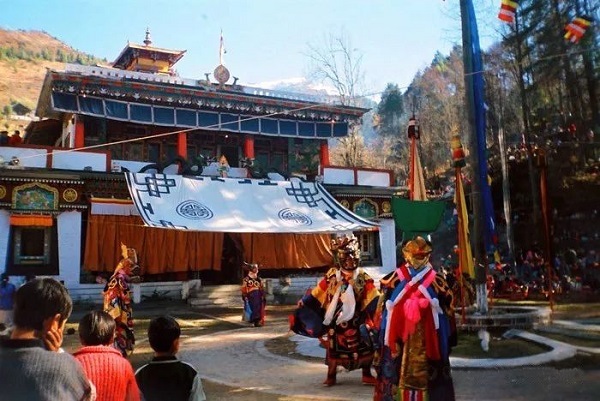 Losar marks the end of the Tibetan calendar and lasts about two weeks. However, the first three days of this long celebration are the most important(except for the Dashain festival). The festival is grandly celebrated not only in Tibet, China but also in neighboring Nepal. Tibetans and Sherpas living in the alpine regions of northern Nepal commemorate Lhosar with religious ceremonies and parades. In the Kathmandu Valley, there are also big celebrations in the Tibetan areas around Boudhanath Stupa.
Losar marks the end of the Tibetan calendar and lasts about two weeks. However, the first three days of this long celebration are the most important(except for the Dashain festival). The festival is grandly celebrated not only in Tibet, China but also in neighboring Nepal. Tibetans and Sherpas living in the alpine regions of northern Nepal commemorate Lhosar with religious ceremonies and parades. In the Kathmandu Valley, there are also big celebrations in the Tibetan areas around Boudhanath Stupa.
On the first day of Lhosar, Nepalese often drink Chaang, an alcoholic beverage. The next day, Nepalese would go to a nearby temple, where monks would perform traditional rituals to expel evil. On the third day, Nepalese gather with family and friends to celebrate the holiday.
Holi/Fagun Purnima
Date:
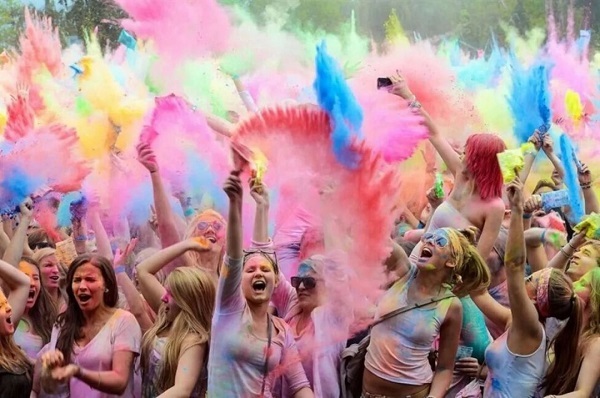 Holi/Fagun Purnima is regarded as the most exciting, funny, colorful and joyful festival in Nepal. It is held in late November of the Nepali calendar (March of the Gregorian calendar) and lasts for 7 days. This Nepali festival originated from the mythical story of the banshee Hori being burned to ashes, so it is also called the "Holi Festival".
Holi/Fagun Purnima is regarded as the most exciting, funny, colorful and joyful festival in Nepal. It is held in late November of the Nepali calendar (March of the Gregorian calendar) and lasts for 7 days. This Nepali festival originated from the mythical story of the banshee Hori being burned to ashes, so it is also called the "Holi Festival".
During the festival, not only do family members sprinkle the red powder on each other's faces or heads to give best wishes but also people walking on the street throw pink powder on each other no matter whether they know each other or not. In recent years, apart from sprinkling red powder, people also use water guns, balloons and other items filled with red liquid. Don't be offended if you get drenched with red, because Nepalese people regard the color red as a symbol of good luck.
Nepali New Year/Bisket Jatra
Date:
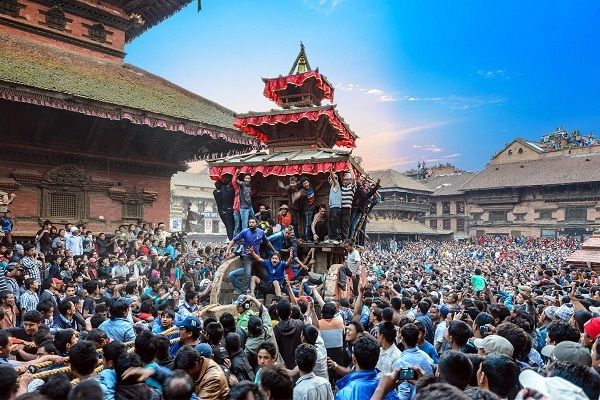
Nepali New Year usually falls between April 11th and 15th in the Gregorian calendar. Due to the multi-ethnic and deep-rooted traditions, Nepal actually has 9 different New Years. But the New Year on Nepali Sambat (Nepali lunar calendar) is considered the national New Year, which brings a kind of symbol of unity in a vast diversity of languages, cultures and histories. At Hindu temples across Nepal, crowds gather for morning prayer and provide offerings to the gods. Then, the faithful believers would circuit the temples counterclockwise and ring the bells.
Buddha Jayanti
Date:
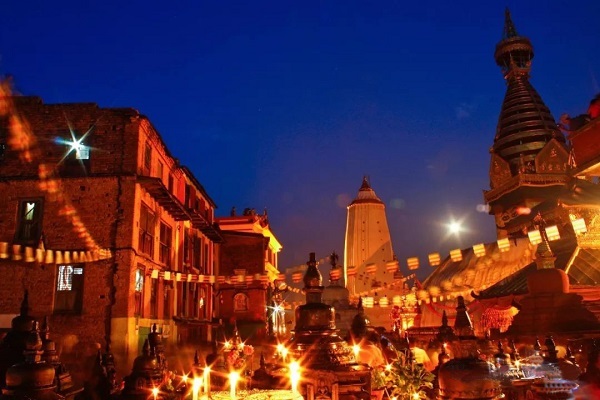 Buddhists in Nepal celebrate Buddha Jayanti (the birth of Buddha) on the full moon day of Baishakh (the Buddhist month). In Nepal, Buddha Jayanti has a special meaning for many people because Nepal is the birthplace of Shakyamuni, previously named Siddhartha Gautama. In 623 BC, King Śuddhodana Gautama and Queen Maya Devi gave birth to Prince Siddhartha Gautama in Lumbini, and the festival is to commemorate the birth of the Buddha. Celebrations for Buddha Jayanti in Lumbini and Kathmandu are the most striking. On the eve of Buddha Jayanti, monks and pilgrims to Lumbini Garden are not only believers from Nepal but also Buddhists from China, India, Thailand, Myanmar, Korea, Japan and other parts of the world.
Buddhists in Nepal celebrate Buddha Jayanti (the birth of Buddha) on the full moon day of Baishakh (the Buddhist month). In Nepal, Buddha Jayanti has a special meaning for many people because Nepal is the birthplace of Shakyamuni, previously named Siddhartha Gautama. In 623 BC, King Śuddhodana Gautama and Queen Maya Devi gave birth to Prince Siddhartha Gautama in Lumbini, and the festival is to commemorate the birth of the Buddha. Celebrations for Buddha Jayanti in Lumbini and Kathmandu are the most striking. On the eve of Buddha Jayanti, monks and pilgrims to Lumbini Garden are not only believers from Nepal but also Buddhists from China, India, Thailand, Myanmar, Korea, Japan and other parts of the world.
Naga Panchami
Date:
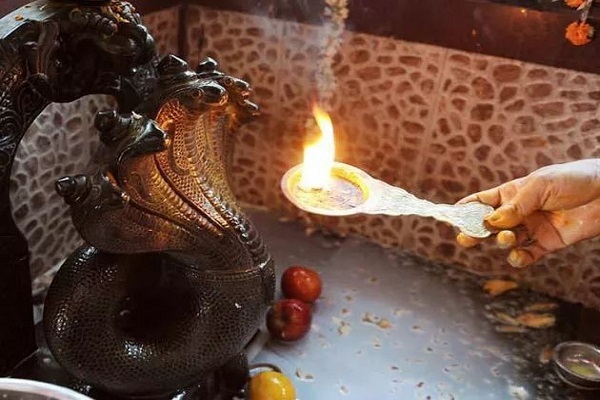 Naga Panchami is also called the Nepali Snake Festival. Hindus in Nepal regard cobras as gods and call them Naga during festivals. The festival celebrated in honor of the snake god or Nag Devta is called Nag Panchami. On this day, believers would worship live cobras or their images. Snake worship is basically rooted in humans' natural fear of reptiles. Hindu books are full of stories and fables about snakes, and pictures and images of snakes can be seen at any time.
Naga Panchami is also called the Nepali Snake Festival. Hindus in Nepal regard cobras as gods and call them Naga during festivals. The festival celebrated in honor of the snake god or Nag Devta is called Nag Panchami. On this day, believers would worship live cobras or their images. Snake worship is basically rooted in humans' natural fear of reptiles. Hindu books are full of stories and fables about snakes, and pictures and images of snakes can be seen at any time.
Nepalese Hindus look for holes where snakes might be found and then visit these holes regularly, placing milk, bananas and other foods that the snakes might like.
Rakshya Bandhan /Janai Purnima
Date:
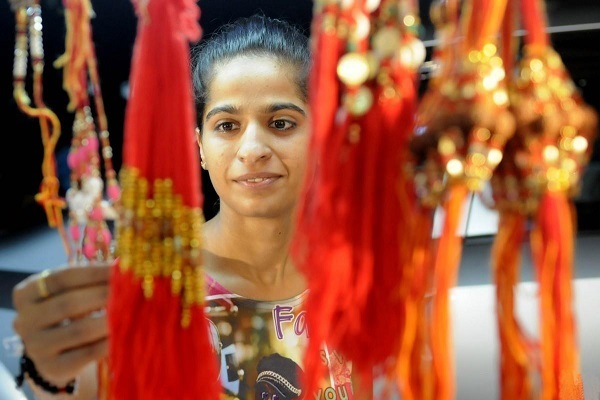 “Rakshya” means protection in Sanskrit, and “Bandhan” means knotted rope, which also has the meaning of protection. The knotting ritual is held after the ceremony (point red dots and feed dessert). The older sister ties the rope to the younger brother's hands and the younger brother returns a gift and also ties a rope to his sister. It means that the older sister loves the younger brother, and the brother will protect his sister all his life. It is celebrated on the full moon day of Shrawan (Nepalese fourth month).
“Rakshya” means protection in Sanskrit, and “Bandhan” means knotted rope, which also has the meaning of protection. The knotting ritual is held after the ceremony (point red dots and feed dessert). The older sister ties the rope to the younger brother's hands and the younger brother returns a gift and also ties a rope to his sister. It means that the older sister loves the younger brother, and the brother will protect his sister all his life. It is celebrated on the full moon day of Shrawan (Nepalese fourth month).
On this day, Hindu men all over the world, especially those of the Brahmin and Chhetri castes, will replace the sacred cords on their wrists or necks (given by the Hindu ritual Bratabandhan). Gosainkunda, not far from Kathmandu, is the biggest and liveliest site of the festival.
Gai Jatra
Date:
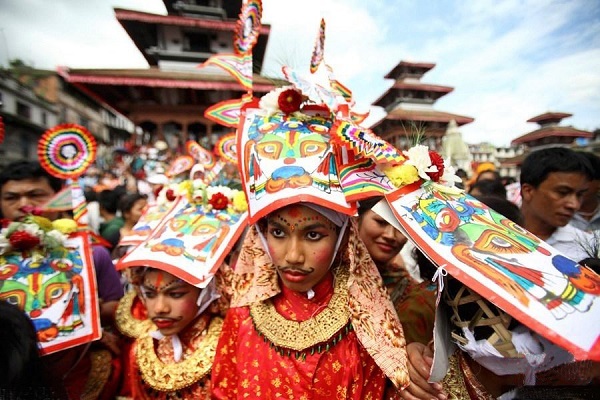
The Gai Jatra began in the Middle Ages as a religious social event for people to miss their dead loved ones. On this day, families who have lost someone are all leading cows to participate in the parade. Families without a cow can let the boy dress up as a cow and pray for the deceased. They believe that cows can lead the dead to heaven. The most lively places are the three ancient capitals in the Kathmandu Valley: Kathmandu Durbar Square, Patan Durbar Square, and Bhaktapur Durbar Square. There is also an equal rights march for gay and transgender groups on the day.
Krishna Janmastami/ Gaura Festival
Date:
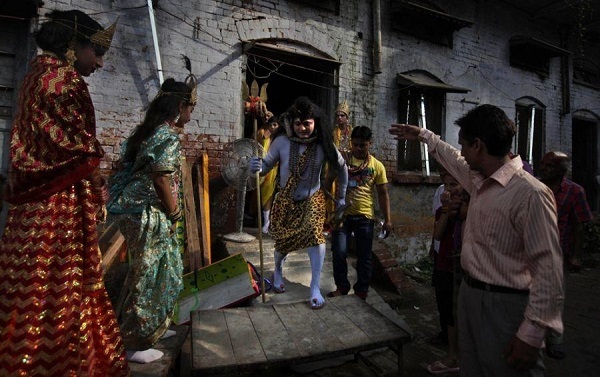 Every year in Nepalese May (late August in the Gregorian calendar) is the day to celebrate the birth of the God of Krishna. On the day, people gather around the Krishna Temple (Krishna Mandir), and then go in and worship one by one reverently. Large and small oil lamps will be lit up around the temple, where the devotees will spend a whole night keeping watch over Krishna and chant hymns to praise him.
Every year in Nepalese May (late August in the Gregorian calendar) is the day to celebrate the birth of the God of Krishna. On the day, people gather around the Krishna Temple (Krishna Mandir), and then go in and worship one by one reverently. Large and small oil lamps will be lit up around the temple, where the devotees will spend a whole night keeping watch over Krishna and chant hymns to praise him.
Hartalika Teej
Date:
Hindu women in Nepal celebrate Hartalika Teej every year on public holidays to commemorate the marriage of Lord Shiva and the Hindu goddess Hartalika. Hartalika Teej arrives on the third day of the full moon of the Hindu month Bhadrapada (August/September in the Gregorian calendar). This holiday marks the beginning of the monsoon season in Nepal.
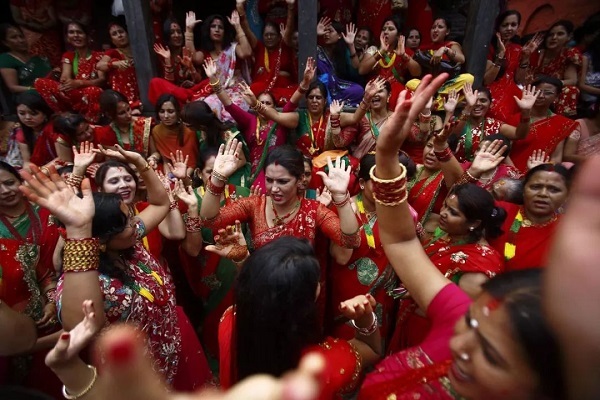 During this Nepal festival, women fast and pray for the health and happiness of their husbands and families. Unmarried young girls pray that they will have a happy marriage one day. There are also many special events at Hartalika Teej, which last for three days.
During this Nepal festival, women fast and pray for the health and happiness of their husbands and families. Unmarried young girls pray that they will have a happy marriage one day. There are also many special events at Hartalika Teej, which last for three days.
On the first day, women dressed in red dresses gathered together to sing and dance. Feast all day until midnight, when it's the beginning of fasting on the second day. Some of them don't even drink a sip of water all day and go to the Shiva Temple to worship and pray. In the evening of the next day, a lamp stayed on all night. Then on the third day of Rishi Panchami, the women will bathe in the sacred river Bagmati and pray afterward, asking for blessings and forgiveness.
>> See more about Hartalika Teej
Rishi Panchami
Date:
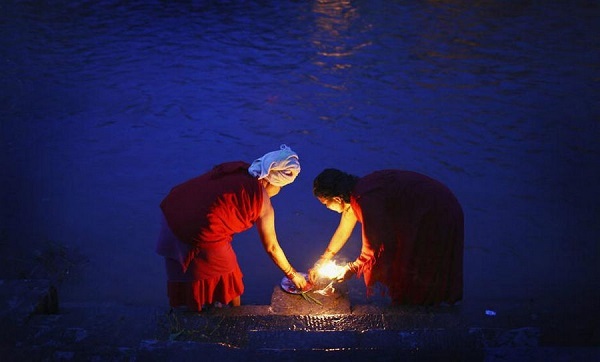
Rishi Panchami is actually the last day of Hartalika Teej. During the festival, women pray on the banks of the river. On this day, women will worship the seven saints and ask them to forgive them for their sins during menstruation throughout the year. Hinduism believes that menstruation is impure, so women are prohibited from participating in all religious activities during menstruation.
Indra Jatra
Date:
Indra Jatra is an important annual festival in Nepal, especially in the capital Kathmandu.
“Indra” is the name of Hinduism`s rain god and "Jatra" means "parade". Therefore, Indra Jatra is a parade to commemorate the Hindu god Indra.
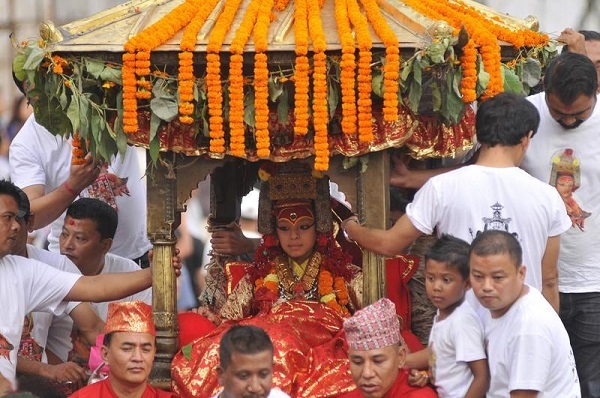 It is the largest street parade festival in Kathmandu, Nepal. The eight-day Indra festival is held in September. It is also one of the most exciting and respected Newar festivals in the Kathmandu Valley. It also marks the beginning of a month-long festival in autumn. It opens with the erection of a pillar made of pine on Basantapur Durbar Square in front of the old Hanuman Dhoka palace. During the pillar erecting ceremony, hundreds of sightseers gather in the palace square and surrounding temples. The Living Goddess Kumari is pulled out for a parade through Kathmandu's main street. Lakhe, a dancer with a mask, walks the streets with the sound of drums every night.
It is the largest street parade festival in Kathmandu, Nepal. The eight-day Indra festival is held in September. It is also one of the most exciting and respected Newar festivals in the Kathmandu Valley. It also marks the beginning of a month-long festival in autumn. It opens with the erection of a pillar made of pine on Basantapur Durbar Square in front of the old Hanuman Dhoka palace. During the pillar erecting ceremony, hundreds of sightseers gather in the palace square and surrounding temples. The Living Goddess Kumari is pulled out for a parade through Kathmandu's main street. Lakhe, a dancer with a mask, walks the streets with the sound of drums every night.
The festival commemorates the moment when Indra came down from heaven to earth in search of herbs. Every night during the Indra festival, oil lamps are lit on the altar and ancient palace buildings around Durbar Square in Kathmandu. Every night, on the platform in front of the Kumari Temple, there are performances of ten human incarnations of Vishnu, who is a guardian god of Hinduism. On the afternoon before the full moon, fanatical believers gather near Hanuman Dhoka Palace to wait for the Living Goddess.
Dashain
Date: – 25
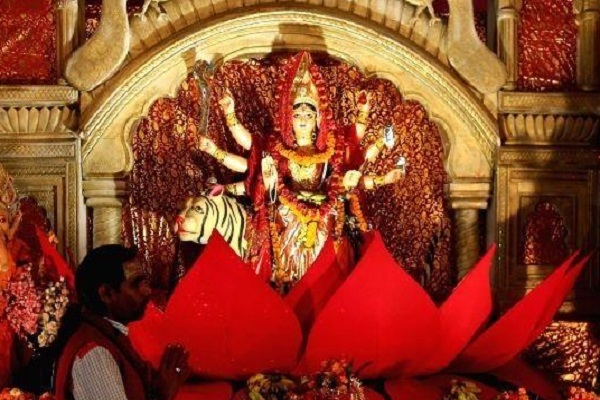 Ghatasthapana is the first day of Dashain, which is the largest and most famous annual festival in Nepal. It is held at the time of the full moon from September to October each year for 9 consecutive days. National holidays range from 10 to 15 days. It is a celebration of good prevailing over evil.
Ghatasthapana is the first day of Dashain, which is the largest and most famous annual festival in Nepal. It is held at the time of the full moon from September to October each year for 9 consecutive days. National holidays range from 10 to 15 days. It is a celebration of good prevailing over evil.
Dashain is to commemorate the victory of the goddess Durga over the Demon Mahishasura. According to legend, Durga, the goddess, with nine hands and ten incarnations, dressed in a red robe, riding a lion, holding different weapons and magic weapons in each hand, and backed by the gods, fought fiercely against the demons for nine days and nights.
She finally defeated the demon on the tenth day. "Dashain" means "tenth" in Nepali. The night of the ninth day is called " the night of Dashain", and the tenth day is called “the tenth day of victory”. On the third or fourth day of the festival, the eldest in the family points out the "Tika" on the foreheads of the younger generations, symbolizing auspiciousness. People also visit relatives and friends and taste delicious food at this festival.
>> See more about Dashain Festival
Tihar
Date:
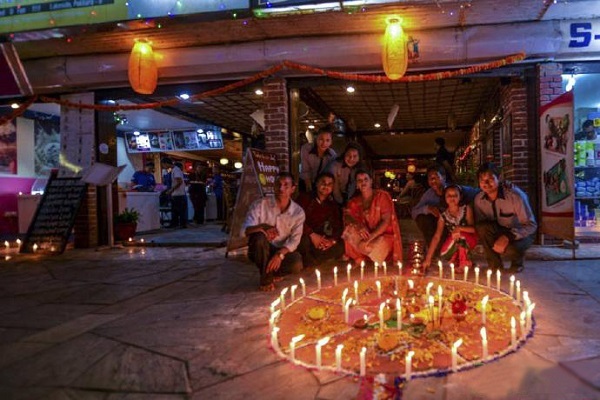
The Tihar festival originates in India, known for its colorful lights. Tihar is celebrated by worshipping Goddess Laxmi with vigour and enthusiasm. The five-day festival begins in late October or early November. On the first day, Nepalese worship the crow; on the next day, worship the dog; on the third day, worship Goddess Laxmi; on the fourth day, worship the cow; on the fifth day, point an auspicious tika on the forehead of brothers praying for their long life. In the latter part of the festival, it's said that the goddess of wealth Laxmi will descend to the world, so Nepalis greet her with brilliant lights. It is also a good experience to see Kathmandu from the Monkey Temple that night.
>> See more about Tihar Festival
Chaath Puja
Date:
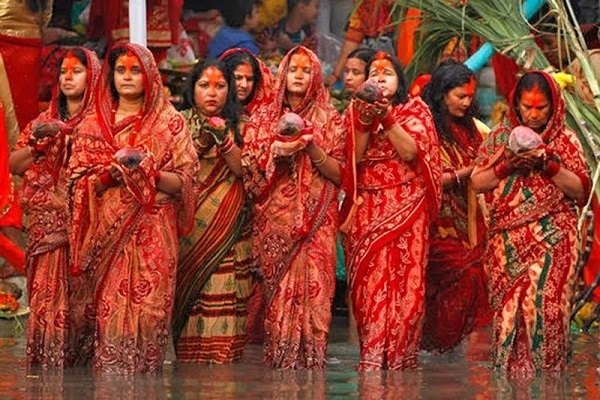 Chaath Puja is the most important festival in the Terai region of Nepal. The worshippers would gather at the riverbank, fast, pray and worship the sun, eulogizing the solar deity. Women worship the gods at sunrise and sunset, and prayers usually pray for the happiness and well-being of children first. They will also worship the sun god in a parade. Fresh grains, candies and fruits will be offered as sacrifices to the gods. The Terai area is the best place to watch the festival. If you can't go that far, you may head to Rani Pokhari in the center of Kathmandu.
Chaath Puja is the most important festival in the Terai region of Nepal. The worshippers would gather at the riverbank, fast, pray and worship the sun, eulogizing the solar deity. Women worship the gods at sunrise and sunset, and prayers usually pray for the happiness and well-being of children first. They will also worship the sun god in a parade. Fresh grains, candies and fruits will be offered as sacrifices to the gods. The Terai area is the best place to watch the festival. If you can't go that far, you may head to Rani Pokhari in the center of Kathmandu.
Email response within 0.5~24 hours.


